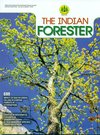Ethephon (2-Chloroethylphosphonic Acid) Application and Gummosis in Anogeissus pendula Edgew.
DOI:
https://doi.org/10.36808/if/2018/v144i8/132215Keywords:
Bundelkhand Region, Gum Inducer, Gum-Gatti, Sugar Content.Abstract
Present study was carried out to standardize the dose of ethephon (2- chloroethylphosphonic acid), a gum inducer hormone and suitable month for its application to optimize gum yield from Anogeissus pendula without deteriorating tree health. Separate A. pendula trees were used to inject with three different doses of ethephon viz., 390 mg/4ml (10%), 780 mg/4 ml (20%) and 1170 mg/4 ml (30%) active ingredients at monthly intervals during a complete year (March, 2010 to February, 2011). Increase in mean gum yield with the increase in ethephon dose was recorded. Maximum mean gum yield was recorded in March, 2010 (57.18 g/tree) and minimum in August, 2010 (0.17 g/tree). The cumulative gum yield was recorded maximum during summer (1028.90 g), followed by winter (965.00 g) and rainy season (862.00 g). Applications of ethephon had no effect on tree health; however, its use significantly increased sugar content of the wood after one month of the application. Higher dose of ethephon produced higher sugar content in the wood of A. pendula. Thus, the results of present study suggested that higher gum yield can be obtained from higher dose of ethephon during summer season, without affecting the tree health.References
Abib C.F., Ntoupka M., Peltier R., Harmand J.M. and Thaler P. (2013). Ethephon: a tool to boost gum Arabic production from Acacia senegal and to enhance gummosis processes. Agroforestry Systems, 87(2): 427-438.
Bhatt J.R. and Ram Mohan Y.H. (1990). Ethephon-induced gum production in Acacia senegal and its potential value in the semiarid regions of India. Current Science, 59(23): 1247-1250.
Bhatt J.R. (1987). Gum tapping in Anogeissus latifolia (Combretaceae) using ethephon. Current Science, 56(18): 936940.
Dian K., Okoma M.K., Koffi E.K., Pokou D.N., Kan M.K., Kouadjo G.Z., Kouassi, N.K., Sangare A. and Obouayeba S. (2016). Effect of ethephon stimulation frequency in downward tapping on the production potential in upward tapping among PB 260 clone of Hevea brasiliensis in Ivory Coast. Inter. J. Agro. and Agri. Research, 8(2): 51-63.
Hall M.A. and Smith A.R. (1995). Ethylene and the responses of plants to stress. Bulgarian J. Plant Physiology, 21(2-3): 71-79.
Harsh L.N., Tewari J.C., Khan H.A. and Ram M. (2013). Ethephon-induced gum Arabic exudation technique and its sustainability in arid and semi-arid regions of India. Forests, Trees and Livelihoods, 22(3): 204-211.
Kuruwanshi V.B. and Katiyar P. (2017). Establishment of sustainable gum tapping techniques in dhawda (Anogeiussus latifolia) using ethephon. Trends in Biosciences, 10(6): 1137611380.
Li Z., Zhu W., Fan Y.C., Ye J.L. and Li G.H. (2014). Effects of preand post-treatment with ethephon on gum formation of peach gummosis caused by Lasiodiplodia theobromae. Plant Pathology, 63(6): 1306-1315.
Miyamoto K., Kotake T., Sasamoto M., Saniewski M. and Ueda J. (2010). Gummosis in grape hyacinth (Muscari armeniacum) bulbs: hormonal regulation and chemical composition of gums. J. Plant Research, 123(3): 363-370.
Prasad R., Uikey N.K., Tripathi V.D. and Dhyani S.K. (2014). Effect of gum inducer (ethephon) on yield and physico-chemical properties of gum exudate from Butea monosperma L. Indian J. Agroforestry, 16(2): 73-80.
Prasad R., Venkatesh A., Tripathi V.D. and Dhyani S.K. (2016). Indigenous method of tapping gum-butea and its impact on livelihood of Saharia tribe in Central India. Indian Forester, 142(3): 221-226.
Yemm E.W. and Willis A.J. (1954). The estimation of carbohydrates in plant extracts by Anthrone. Biochemical Journal, 57: 508-514.
Downloads
Downloads
Published
How to Cite
Issue
Section
License
Unless otherwise stated, copyright or similar rights in all materials presented on the site, including graphical images, are owned by Indian Forester.





